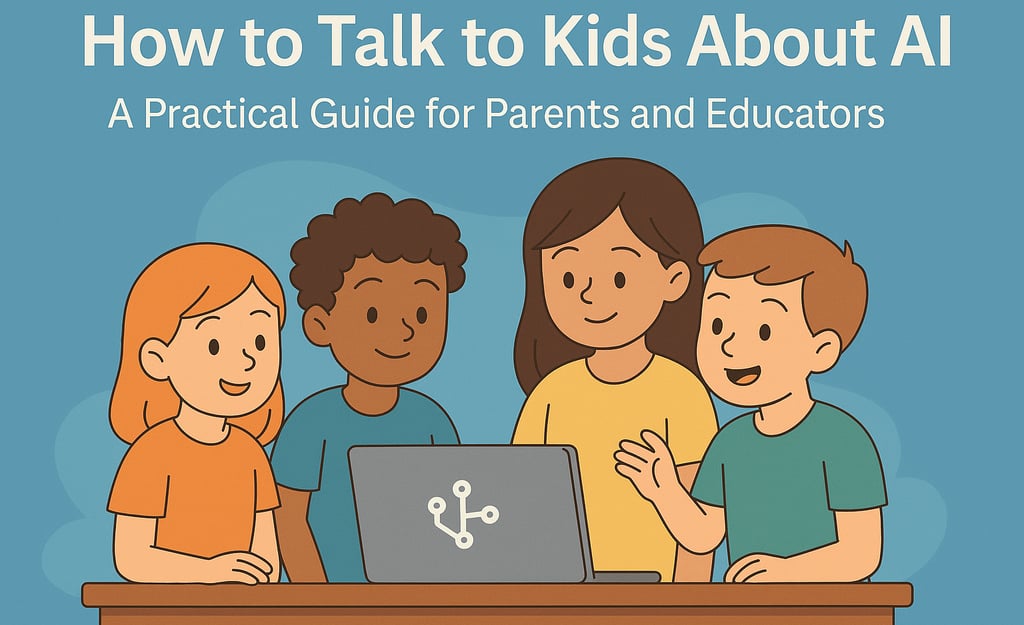Introduction
Artificial intelligence (AI) has gone from a futuristic concept to a part of our daily lives. Children are now growing up in an environment where AI tools help decide what videos they watch, suggest songs to listen to, assist with homework, and even talk back through voice assistants. As a result, it’s becoming more important than ever to talk to children about AI—not in technical terms, but in a way that helps them understand, question, and engage responsibly with this powerful technology. Whether you're a parent, teacher, or mentor, this guide will help you navigate these conversations.
1. Why Kids Need to Understand AI
Kids interact with AI every day, often without realizing it. When Netflix suggests a new cartoon, or Alexa answers a trivia question, that's AI at work. If we don’t explain what's behind the curtain, children may assume these systems are magical or flawless, which can lead to misconceptions. Teaching them about AI—what it can and can't do, and how it works—gives them tools to be more thoughtful users. It also encourages early interest in STEM and ethics, both critical for the next generation.
More importantly, kids will eventually face situations where AI affects their lives in serious ways—job hiring decisions, privacy rights, education algorithms. Understanding AI prepares them to ask questions, demand fairness, and advocate for themselves in a digital world.
2. How to Start the Conversation
The best way to introduce AI to children is by connecting it to things they already know. Start small: "Have you ever noticed how YouTube knows what you want to watch next?" or "Do you know why Siri sometimes doesn’t understand you?" Use everyday moments to build curiosity. You don’t have to be an expert—just willing to explore together.
Use metaphors they can grasp. For example, you can say: "AI is like a robot brain that learns from lots and lots of examples." Show them how you use ChatGPT or voice tools, and ask what they think about it. Let them explore AI-powered drawing tools or chatbots in a fun way, then reflect together on what makes those tools smart—or sometimes not so smart.
3. Age-Appropriate Ways to Explain AI
For younger children (ages 5–8), focus on the idea that machines can follow instructions and learn from patterns. Use storybooks or animated videos to demonstrate how technology ‘thinks’.
For middle schoolers (ages 9–12), introduce simple concepts like data, algorithms, and predictions. For instance, explain how a game might learn to get harder because it's noticing they’re winning easily.
Teenagers (13+) can handle more nuanced discussions about bias, misinformation, and data privacy. Ask them about deepfakes or TikTok’s For You page—these are perfect entry points for discussing how AI systems impact what we see and believe.
4. Benefits of Understanding AI
Learning about AI helps children become critical thinkers. They can better judge information online, recognize when technology is manipulating them, and avoid falling for scams or misleading content. It also builds digital literacy and empowers them to make informed choices about the tools they use.
Understanding AI can also open up career paths. From coding to design to ethics, AI touches many fields. Children who understand these systems early are more likely to shape the future of technology, not just consume it.
5. Teaching Ethical Awareness
It’s never too early to talk about ethics. AI may seem neutral, but it’s built by humans who make choices about what data to use and how systems behave. Talk to kids about fairness. Is it fair if a robot grades homework? What if it gets things wrong? Discuss cheating, plagiarism, and how AI writing tools should be used responsibly in school.
Model ethical tech behavior. If you’re using AI to write emails or summarize articles, be honest about it. Kids learn more from what we do than what we say.
6. Risks and Challenges of AI
AI has downsides too. Kids should know that some systems can be biased, like facial recognition that doesn’t work equally well for everyone. Or chatbots that generate incorrect answers. AI also uses massive amounts of data—raising concerns about privacy, consent, and security.
Explain how using AI tools may collect personal information, and what it means to give an app access to your voice, face, or location. Teaching kids how to read permissions and protect their data is a key life skill.
7. Environmental and Social Considerations
Many don’t realize that AI consumes a lot of resources. Training large models uses enormous electricity and water. This affects climate change and ecosystems. Let kids connect tech use with caring for the planet. Ask: "What’s the cost of streaming videos all day?" and "How can we use tech in a greener way?"
Socially, AI could widen inequality. Not all students have equal access to AI tutors or educational tools. Talk about tech privilege, and the importance of designing inclusive systems that help everyone, not just the rich or tech-savvy.
8. Fun AI Activities for Kids
There are many engaging ways to learn about AI hands-on. Here are a few ideas:
• Use AI-based drawing apps like DALL·E or Scribble Diffusion.
• Create your own chatbot using tools like Scratch or MIT App Inventor.
• Visit museums or YouTube channels that explain AI with kid-friendly animations.
• Try a family experiment: ask ChatGPT a silly question and then ask each other how you think it came up with the answer.
Conclusion
Helping kids understand AI isn’t about turning them into engineers—it’s about equipping them with curiosity, awareness, and values. The future will be full of smart technologies, but the smartest thing we can do is teach kids to question, learn, and lead with empathy. As AI continues to evolve, so must the way we talk about it. Make these conversations part of daily life. Kids don’t need perfect answers—they need people who are willing to explore the future with them.

